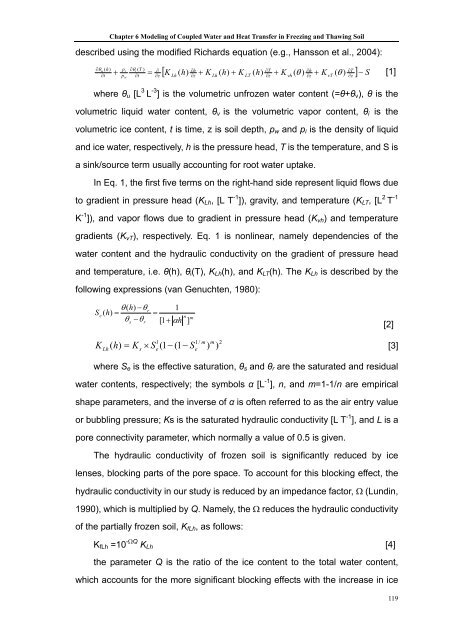SCHRIFTENREIHE Institut für Pflanzenernährung und Bodenkunde ...
SCHRIFTENREIHE Institut für Pflanzenernährung und Bodenkunde ...
SCHRIFTENREIHE Institut für Pflanzenernährung und Bodenkunde ...
Create successful ePaper yourself
Turn your PDF publications into a flip-book with our unique Google optimized e-Paper software.
Chapter 6 Modeling of Coupled Water and Heat Transfer in Freezing and Thawing Soil<br />
described using the modified Richards equation (e.g., Hansson et al., 2004):<br />
∂h<br />
∂T<br />
∂h<br />
∂T<br />
[ ( h)<br />
+ K ( h)<br />
+ K ( h)<br />
+ K ( θ ) + K ( θ ) ] S<br />
∂θ<br />
( h) pi<br />
∂θi<br />
( T ) ∂<br />
∂t<br />
+ p t = z K<br />
w ∂ ∂ Lh ∂z<br />
Lh<br />
LT ∂z<br />
vh ∂z<br />
vT ∂z<br />
u −<br />
where θu [L 3 L -3 ] is the volumetric unfrozen water content (=θ+θv), θ is the<br />
volumetric liquid water content, θv is the volumetric vapor content, θi is the<br />
volumetric ice content, t is time, z is soil depth, pw and pi is the density of liquid<br />
and ice water, respectively, h is the pressure head, T is the temperature, and S is<br />
a sink/source term usually accounting for root water uptake.<br />
In Eq. 1, the first five terms on the right-hand side represent liquid flows due<br />
to gradient in pressure head (KLh, [L T -1 ]), gravity, and temperature (KLT, [L 2 T -1<br />
K -1 ]), and vapor flows due to gradient in pressure head (Kvh) and temperature<br />
gradients (KvT), respectively. Eq. 1 is nonlinear, namely dependencies of the<br />
water content and the hydraulic conductivity on the gradient of pressure head<br />
and temperature, i.e. θ(h), θi(T), KLh(h), and KLT(h). The KLh is described by the<br />
following expressions (van Genuchten, 1980):<br />
θ ( h)<br />
−θ<br />
r 1<br />
Se<br />
( h)<br />
= =<br />
n<br />
θ −θ<br />
[ 1+<br />
αh<br />
]<br />
s<br />
K ( h)<br />
−<br />
Lh<br />
r<br />
m<br />
l<br />
1/<br />
m m 2<br />
= Ks<br />
× Se<br />
( 1−<br />
( 1 Se<br />
) )<br />
[3]<br />
where Se is the effective saturation, θs and θr are the saturated and residual<br />
water contents, respectively; the symbols α [L -1 ], n, and m=1-1/n are empirical<br />
shape parameters, and the inverse of α is often referred to as the air entry value<br />
or bubbling pressure; Ks is the saturated hydraulic conductivity [L T -1 ], and L is a<br />
pore connectivity parameter, which normally a value of 0.5 is given.<br />
The hydraulic conductivity of frozen soil is significantly reduced by ice<br />
lenses, blocking parts of the pore space. To account for this blocking effect, the<br />
hydraulic conductivity in our study is reduced by an impedance factor, Ω (L<strong>und</strong>in,<br />
1990), which is multiplied by Q. Namely, the Ω reduces the hydraulic conductivity<br />
of the partially frozen soil, KfLh, as follows:<br />
KfLh =10 -ΩQ KLh [4]<br />
the parameter Q is the ratio of the ice content to the total water content,<br />
which accounts for the more significant blocking effects with the increase in ice<br />
[1]<br />
[2]<br />
119


